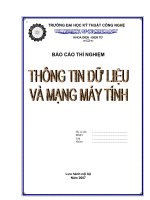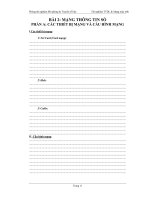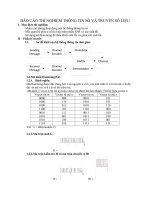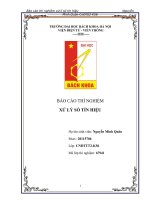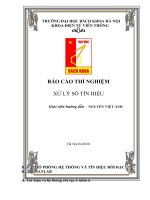BÁO CÁO THÍ NGHIỆM THÔNG TIN SỐ
Bạn đang xem bản rút gọn của tài liệu. Xem và tải ngay bản đầy đủ của tài liệu tại đây (750.27 KB, 21 trang )
BÁO CÁO THÍ NGHIỆM THƠNG TIN SỐ
Họ và tên: Lê Văn Lưu
MSSV: 20172675
BÀI 1. MÔ PHỎNG NHIỄU GAUSS
1.1.
-
Hàm mật độ xác suất
Code
>> Px=1/(sqrt(2*pi))*exp(-x.^2/2);
>> plot(x,Px);
>> title('Ham phan bo xac xuat Gauss');
>> xlabel('x');
>> ylabel('Px');
-
1.2.
-
Kết quả:
Code:
len = 100000;
x = randn(1,len);
step = .1;
k = -5:step:5;
px = hist(x,k)/len/step;
stem(k,px);
Px_lythuyet = exp(-k.^2/2)/sqrt(2*pi);
hold on;
plot(k,Px_lythuyet);
title(' Phan bo xac suat Gauss ');
xlabel('x');
ylabel('P(x)');
legend('Ly thuyet','Mo phong');
hold off;
Kết quả:
BÀI 2. KỸ THUẬT LƯỢNG TỬ HĨA TUYẾN TÍNH
2.1.
-
-
Code:
xs = rand(1,5)*2-1;
[xi,xq] = lquan(xs,-1,1,3)
Kết quả:
xs = [0.0847 -0.8878 -0.2499 0.0359 0.9544]
xi = [4 0 3 4 7]
xq = [0.1250 -0.8750 -0.1250 0.1250 0.8750]
Trả lời câu hỏi:
Dòng lệnh sử dụng: [xi,xq] = lquan(xs,-1,1,3)
Xs = [0.0847 -0.8878 -0.2499 0.0359 0.9544]
xi = [4 0 3 4 7]
xq = [0.1250 -0.8750 -0.1250 0.1250 0.8750]
Dòng bit được truyền 15bit = 100000011100111
2.2.
-
Code:
t=0:.01:20;
xt= sin(randn()+t).*cos(rand()*t);
[inx xqt]=lquan(xt,-1,1,randi(3)+1);
plot(t,xt,'b',t,xqt,'r');
grid on;
title(' Luong tu hoa tuyen tinh ');
xlabel ('t');
ylabel ('y');
legend('xt','xqt');
-
Kết quả:
BÀI 3. TẠP ÂM LƯỢNG TỬ TRONG KỸ THUẬT
LƯỢNG TỬ HĨA TUYẾN TÍNH
Code
N = 1000;
x_uni = 2*rand(1,N)-1;
% x_uni phan bo deu tu -1 den 1
x_sin = sin(linspace(1,5,N));
% tin hieu sin
nbit = 1:10;
% so bit luong tu tu 1 den 10
SNqR_uni = zeros(size(nbit));
% Khoi tao mang SNqR_uni va SNqR_sin chua
SNqR_sin = zeros(size(nbit));
% SNqR cua tin hieu phan bo deu va tin hieu
sin
SNqR_lt = 6.02*nbit;
% Mang chua SNqR tinh theo ly thuyet
Ps_uni = sum(x_uni.^2)/N;
% Cong suat tin hieu x theo (3-3)
Ps_sin = sum(x_sin.^2)/N;
for i = 1:size(nbit,2)
% size(n,2) tra ve so cot cua n
[indx_uni xq_uni] = lquan(x_uni,-1,1,nbit(i)); % Luong tu hoa tin hieu
x_uni
[indx_sin xq_sin] = lquan(x_sin,-1,1,nbit(i)); % Luong tu hoa tin hieu
x_sin
eq_uni = x_uni - xq_uni;
% tinh sai so luong tu hoa x_uni
eq_sin = x_sin - xq_sin;
% tinh sai so luong tu hoa x_sin
Pq_uni = sum(eq_uni.^2)/N;
% tinh cong suat tap am luong tu x_uni
Pq_sin = sum(eq_sin.^2)/N;
% tinh cong suat tap am luong tu x_sin
SNqR_uni(i) = 10*log10(Ps_uni/Pq_uni);
% tinh SNR_db cua x_uni
SNqR_sin(i) = 10*log10(Ps_sin/Pq_sin);
% tinh SNR_db cua x_sin
end
plot(nbit,SNqR_uni,'b-');
% ve do thi SNR tin hieu phan bo deu mo phong
hold on;
plot(nbit,SNqR_sin,'r--');
% ve do thi SNR tin hieu sin mo phong
plot(nbit,SNqR_lt,'m-.');
% Ve do thi SNR tin hieu phan bo deu ly thuyet
title('Do thi SN_qR theo nbit');
xlabel('nbit');
ylabel('SN_qR');
legend('Phan bo deu','Hinh sin','Ly thuyet');
grid on;
hold off;
Kết quả
SNqR_lt = [6.0200 12.0400 18.0600 24.0800 30.1000 36.1200 42.1400 48.1600
54.1800 60.2000]
SNqR_uni = [6.1217 12.0590 18.0125 23.9371 29.9149 36.2382 42.0380
48.2333 54.1255 59.9320]
SNqR_sin = [6.4171 12.8834 19.3981 25.6702 32.0389 38.1620 44.3266
50.4033 56.4544 62.5722]
BÀI 4. MẬT ĐỘ PHỔ NĂNG LƯỢNG VÀ HÀM TỰ TƯƠNG QUAN CỦA TÍN
HIỆU
4.1
Code:
%------------------------------------------------------------------------% Bai 4.1: Tinh va ve do thi ham mat do pho nang luong cua
tin hieu ngau
% nhien x voi do dai L=500 mau
%------------------------------------------------------------------------L=500;
x=randn(1,L);
acorr_x = xcorr(x);
% Ham tu tuong quan cua x
n=-(L-1):1:(L-1);
plot(n,acorr_x);
title('Ham tu tuong quan');
xlabel('n');
ylabel('acorr_x');
hold on;
% Tin hieu co bien do tang dan
x=linspace(-1,1,L);
acorr_x=xcorr(x);
n=-(L-1):1:(L-1);
plot(n,acorr_x,'k--');
hold on;
% Tin hieu since
x=sin(linspace(-10,10,L));
acorr_x=xcorr(x);
n=-(L-1):1:(L-1);
plot(n,acorr_x,'r.');
hold on;
Kết quả:
4.2
Code:
L=50;
% tin hieu x ngau nhien do dai L=50 mau
N=200; % So luong tan so roi rac
x=randn(1,L);
w=linspace(0,2*pi,N);
fx=freqz(x,1,w);
esd_x=fx.*conj(fx);
acorr_x=xcorr(x);
subplot(2,1,1);
semilogy(w/pi,esd_x);
title('Mat do pho nang luong');
xlabel('n');
ylabel('S(ejw)');
hold on;
ft_acorr_x=freqz(acorr_x,1,w).*exp(j*w*(L-1));
subplot(2,1,2);
semilogy(w/pi,real(ft_acorr_x),'r');
xlabel('n');
ylabel('Rxx(ejw)');
Kết quả:
BÀI 5. MÃ ĐƯỜNG DÂY NRZ
Code:
len = 100000;
% Do dai dong bit mo phong
SNR_db = 0:2:8;
% Tao vector SNR_db = 0 2 4 6 8
SNR = 10.^(SNR_db/10);
% Doi SNR tu Decibel sang lan
bsignal = randi([0 1],1,len);
% Dong bit ngau nhiên do dai
len
NRZ_signal = bsignal*2-1;
% Bien doi dòng bit 0 1 sang -1
1
N0 = 1./SNR;
% Cong suat tap am
for i=1:length(SNR_db)
noise = sqrt(N0(i))*randn(1,len);
% Tao tap am noise
voi ti so SNR(i)
r_signal = NRZ_signal + noise;
% Tin hieu thu duoc
= NRZ + noise
NRZ_decoded = sign(r_signal);
% Giai ma tin hieu
NRZ thu duoc
[n,BER(i)] = symerr(NRZ_decoded,NRZ_signal);
% Tinh
xac suat loi
end
plot(SNR_db,BER,'bo--');
% Ve do thi
title('Ty le bit loi');
xlabel('SNR_d_B');
ylabel('BER');
Kết quả:
5.2
Code:
len = 100000;
% Do dai dong bit mo phong
SNR_db = 0:2:8;
% Tao vector SNR_db = 0 2 4 6 8
SNR = 10.^(SNR_db/10);
% Doi SNR tu Decibel sang lan
bsignal = randi([0 1],1,len);
% Dong bit ngau nhiên do dai
len
NRZ_signal = bsignal*2-1;
% Bien doi dòng bit 0 1 sang -1
1
N0 = 1./SNR;
% Cong suat tap am
for i=1:length(SNR_db)
noise = sqrt(N0(i))*randn(1,len);
% Tao tap am noise
voi ti so SNR(i)
r_signal = NRZ_signal + noise;
% Tin hieu thu duoc
= NRZ + noise
NRZ_decoded = sign(r_signal);
% Giai ma tin hieu
NRZ thu duoc
[n,BER(i)] = symerr(NRZ_decoded,NRZ_signal);
% Tinh
xac suat loi
end
plot(SNR_db,BER,'bo--');
% Ve do thi BER
Pe = 1/2*(1-erf(sqrt(SNR)/sqrt(2)));
% Xac suat loi theo
ly thuyet
hold on;
plot(SNR_db,Pe,'r*--');
% Ve do thi Pe
title('Do thi ty le bit loi theo ly thuyet va mo phong');
xlabel('SNR_d_B');
ylabel('BER');
legend('Mo phong','Ly thuyet');
Kết quả:
BÀI 6. KỸ THUẬT ĐIỀU CHẾ SỐ QPSK
Code:
len = 50000;
% Do dai dong bit mo phong
SNR_db = 0;
% SNR co don vi Decibel
SNR = 10^(SNR_db/10);
% Doi SNR tu Decibel sang lan
bsignal = randi([0 1],1,len);
% Tao dong bit ngau nhien do
dai len
% Thuc hien dieu che QPSK
for i=1:2:len
if bsignal(i)==0 & bsignal(i+1)==0
% 00
qpsk_signal((i+1)/2) = exp(j*3*pi/4);
elseif bsignal(i)==0 & bsignal(i+1)==1
% 01
qpsk_signal((i+1)/2) = exp(j*5*pi/4);
elseif bsignal(i)==1 & bsignal(i+1)==1
% 11
qpsk_signal((i+1)/2) = exp(j*7*pi/4);
elseif bsignal(i)==1 & bsignal(i+1)==0
% 10
qpsk_signal((i+1)/2) = exp(j*pi/4);
end
end
Es = std(qpsk_signal)^2;
% Nang luong ky hieu
N0 = Es/SNR;
% Cong suat tap am
% Tao nhieu Gauss
noise = sqrt(N0/2)*(randn(1,length(qpsk_signal))
+j*randn(1,length(qpsk_signal)));
qpsk_awgn = qpsk_signal + noise; % Cho tin hieu dieu che di
qua kenh AWGN
plot(qpsk_awgn,'.');
% Ve bieu do chom sao tin
hieu co nhieu
title('Do thi chom sao 4-QPSK');
xlabel('I');
ylabel('Q');
hold on;
plot(qpsk_signal,'r*');
% Ve bieu do chom sao tin
hieu khong nhieu
plot(exp(j*[0:0.01:2*pi]),'r--');
Kết quả:
+ Trường hợp SNR = 0
+ Trường hợp SNR = 3dB
+ Trường hợp SNR = 6dB
BÀI SỐ 7. XÁC SUẤT LỖI BIT TRONG ĐIỀU CHẾ QPSK
Code:
len = 50000;
% Do dai dong bit mo phong
SNR_db = 0:2:8;
% Tao vector SNR_db = 0 2 4 6 8
SNR = 10.^(SNR_db/10);
% Doi SNR tu Decibel sang lan
bsignal = randi([0 1],1,len);
% Tao dong bit ngau nhien do
dai len
% Thuc hien dieu che QPSK
for i=1:2:len
if bsignal(i)==0 & bsignal(i+1)==0
% 00
qpsk_signal((i+1)/2) = exp(j*3*pi/4);
elseif bsignal(i)==0 & bsignal(i+1)==1
% 01
qpsk_signal((i+1)/2) = exp(j*5*pi/4);
elseif bsignal(i)==1 & bsignal(i+1)==1
% 11
qpsk_signal((i+1)/2) = exp(j*7*pi/4);
elseif bsignal(i)==1 & bsignal(i+1)==0
% 10
qpsk_signal((i+1)/2) = exp(j*pi/4);
end
end
% Tim BER mo phong
for i=1:length(SNR_db)
r_signal = awgn(qpsk_signal,SNR_db(i)); % Dieu che QPSK
di qua nhieu AWGN
for j=1:2:len
% Giai dieu che tin hieu QPSK co nhieu
if real(r_signal((j+1)/2))>=0
if imag(r_signal((j+1)/2))>=0
% Goc phan tu I
r_bsignal(j) = 1;
r_bsignal(j+1) = 0;
else
% Goc phan tu IV
r_bsignal(j) = 1;
r_bsignal(j+1) = 1;
end
else
if imag(r_signal((j+1)/2))>=0
% Goc phan tu II
r_bsignal(j) = 0;
r_bsignal(j+1) = 0;
else
% Goc phan tu
III
r_bsignal(j) = 0;
r_bsignal(j+1) = 1;
end
end
end
[n,BER(i)] = biterr(r_bsignal,bsignal);
end
Pb = 1/2*erfc(1/sqrt(2).*sqrt(SNR));
% Xac suat loi bit
plot(SNR_db,Pb,'ro--');
% Ve do thi Pb ly
thuyet
title('Do thi ty le bit loi ly thuyet va mo phong');
xlabel('SNR_d_B');
ylabel('BER');
hold on;
plot(SNR_db,BER);
% Ve do thi BER mo
phong
legend('Ly thuyet','Mo phong');
hold off;
Kết quả:
Pb lý thuyết: [0.1587
0.1040 0.0565 0.0230 0.0060]
BER mô phỏng: [0.1609 0.1034 0.0549 0.0241 0.0056]
BÀI 8. MÔ PHỎNG ĐIỀU CHẾ M-QAM QUA KÊNH NHIỄU GAUSS
Code:
n_sym = 50000; % So ky tu dieu che
M = [16 64 256]; % So symbol ky hieu
SNR_db = 0:25; % Tao vector SNR = 0 - 25 Decibel
BER = zeros(length(M),length(SNR_db)); % BER de luu ti le loi bit
EbN0 = SNR_db;
Pe = BER;
for k = 1:size(M,2) % size(M,2) la so cot cua M
s_stream = randi([0 M(k)-1],1,n_sym); % Tao dong bieu tuong do dain_sym
s_mod = qammod(s_stream,M(k),0,'GRAY'); % Dieu che M-QAM
for r = 1:size(SNR_db,2) % Vong lap tinh BER
s_mod_awgn = awgn(s_mod,SNR_db(r),'measured'); % Tin hieu qua nhieu
s_demod = qamdemod(s_mod_awgn,M(k),0,'GRAY'); % Giai dieu che M-QAM
[num, ratio] = biterr(s_stream,s_demod); % Tinh ti le loi bit
BER(k,r) = ratio; % Luu ti le loi bit vao BER
EbN0(r) = 10^(SNR_db(r)/20);
Pe(k,r) = berawgn (EbN0(r),'qam',M(k));
end
end
semilogy(SNR_db,BER(1,:),'bo-'); % Ve do thi BER ung voi M = 16
hold on;
plot(EbN0,Pe(1,:),'bo-');
semilogy(SNR_db,BER(2,:),'rs-'); % Ve do thi BER ung voi M = 64
plot(EbN0,Pe(2,:),'rs-');
semilogy(SNR_db,BER(3,:),'m*-'); % Ve do thi BER ung voi M = 256
plot(EbN0,Pe(3,:),'m*-');
grid on;
title('Do thi the hien ty le loi bit M-QAM');
xlabel('SNR_d_B');
ylabel('BER');
legend('16-QAM','64-QAM','256-QAM');
hold off;
Kết quả:
Do thi the hien ty le loi bit MQAM
0
10
16QAM
64QAM
256QAM
2
10
4
BER
10
6
10
8
10
10
10
12
10
0
5
10
15
20
25
SNRdB
SNR =
16-QAM
64-QAM
256QAM
0dB
5dB
10dB
15dB
20dB
25dB
BER
0.2877
0.1644
0.0592
0.0045
5.0000e-06
0
Pe
0.1190
0.1024
0.0743
0.0328
0.0018
1.5868e-12
BER
0.3586
0.2621
0.1526
0.0643
0.0080
4.6667e-05
Pe
0.1779
0.1615
0.1341
0.0901
0.0265
1.0085e-05
BER
0.3951
0.3234
0.2366
0.1415
0.0655
0.0128
Pe
0.2361
0.2213
0.1945
0.1479
0.0786
0.0041



